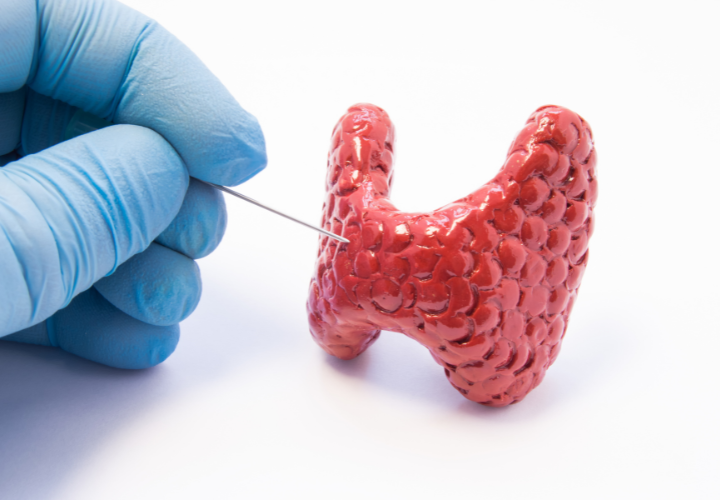A fine needly biopsy of a thyroid nodule may sound frightening, but the needle used is very small and a local anesthetic may not even be necessary. This simple procedure is often done in the doctor’s office. Sometimes, medications like blood thinners may need to be stopped for a few days before the procedure. Otherwise, the biopsy does not usually require any other special preparation (no fasting). Patients typically return home or to work after the biopsy without even needing a bandaid! For a fine needle biopsy, your doctor will use a very thin needle to withdraw cells from the thyroid nodule. Ordinarily, several samples will be taken from different parts of the nodule to give your doctor the best chance of finding cancerous cells if they are present. The cells are then examined under a microscope by a pathologist.
The report of a thyroid fine needle biopsy will usually indicate one of the following findings:
- The nodule is benign (noncancerous)
- This result is obtained in up to 80% of biopsies. The risk of overlooking a cancer when the biopsy is benign is generally less than 3 in 100 tests or 3%. This is even lower when the biopsy is reviewed by an experienced pathologist at a major medical center. Generally, benign thyroid nodules do not need to be removed unless they are causing symptoms like choking or difficulty swallowing. Follow up ultrasound exams are important. Occasionally, another biopsy may be required in the future, especially if the nodule grows over time.
- The nodule is malignant (cancerous) or suspicious of malignancy.
- A malignant result is obtained in about 5% of biopsies and is most often due to papillary cancer, which is the most common type of thyroid cancer. A suspicious biopsy has a 50-75% risk of cancer in the nodule. These diagnoses require surgical removal of the thyroid after consultation with your endocrinologist and surgeon.
- The nodule is indeterminate. This is actually a group of several diagnoses that may occur in up to 20% of cases. An indeterminate finding means that even though an adequate number of cells was removed during the fine needle biopsy, examination with a microscope cannot reliably classify the result as benign or cancer.
- The biopsy may be indeterminate because the nodule is described as a Follicular Lesion. These nodules are cancerous 20-30% of the time. However, the diagnosis can only be made by surgery. Since the odds that the nodule is not a cancer are much better here (70-80%), only the side of the thyroid with the nodule is usually removed. If a cancer is found, the remaining thyroid gland usually must be removed as well. If the surgery confirms hat no cancer is present, no additional surgery to “complete” the thyroidectomy is necessary.
- The biopsy may also be indeterminate because the cells from the nodule have features that cannot be placed in one of the other diagnostic categories. The diagnosis is called atypic, or a follicular lesion of undetermined significance. Diagnoses in this category will contain cancer rarely, so repeat evaluation with FNA or surgical biopsy to remove half of the thyroid containing the nodule is usually recommended.
- The biopsy may also be non-diagnostic or inadequate. This result is obtained in less than 5% of cases when an ultrasound is used to guide the FNA. This result indicates that not enough cells were obtained to make a diagnosis but is a common result if the nodule is a cyst. These nodules may require revelation with second fine needle biopsy, or may need to be removed surgically depending on the clinical judgment of your doctor.
Follow us on social





